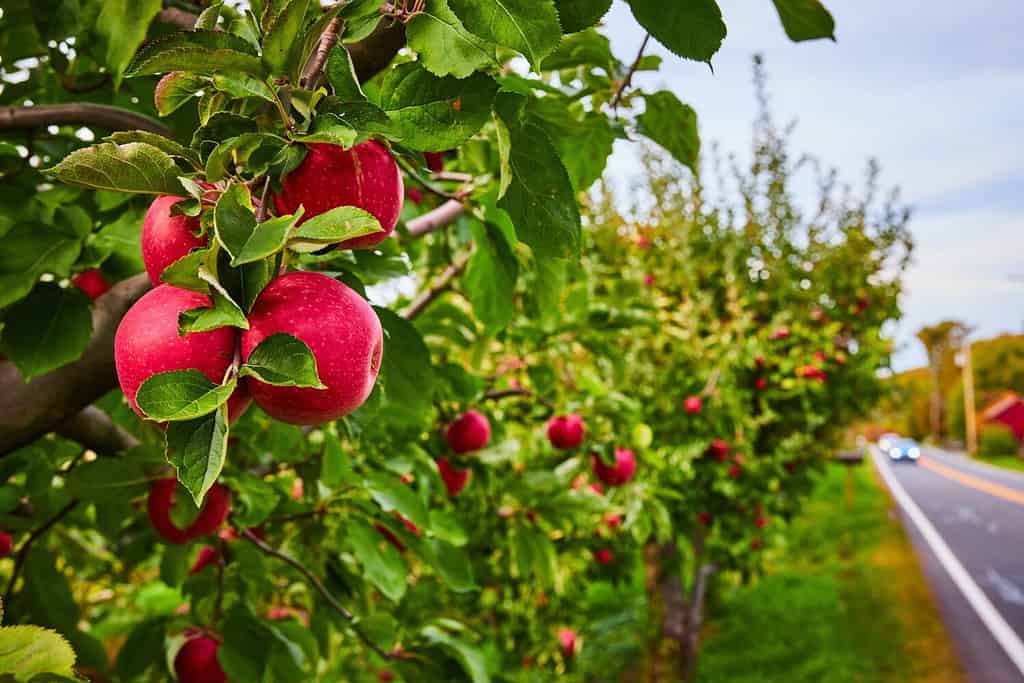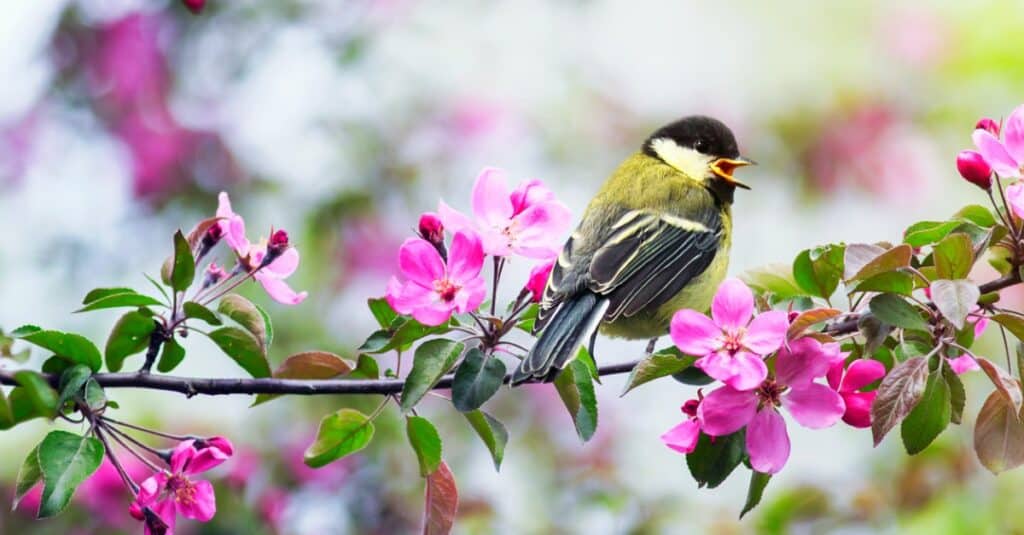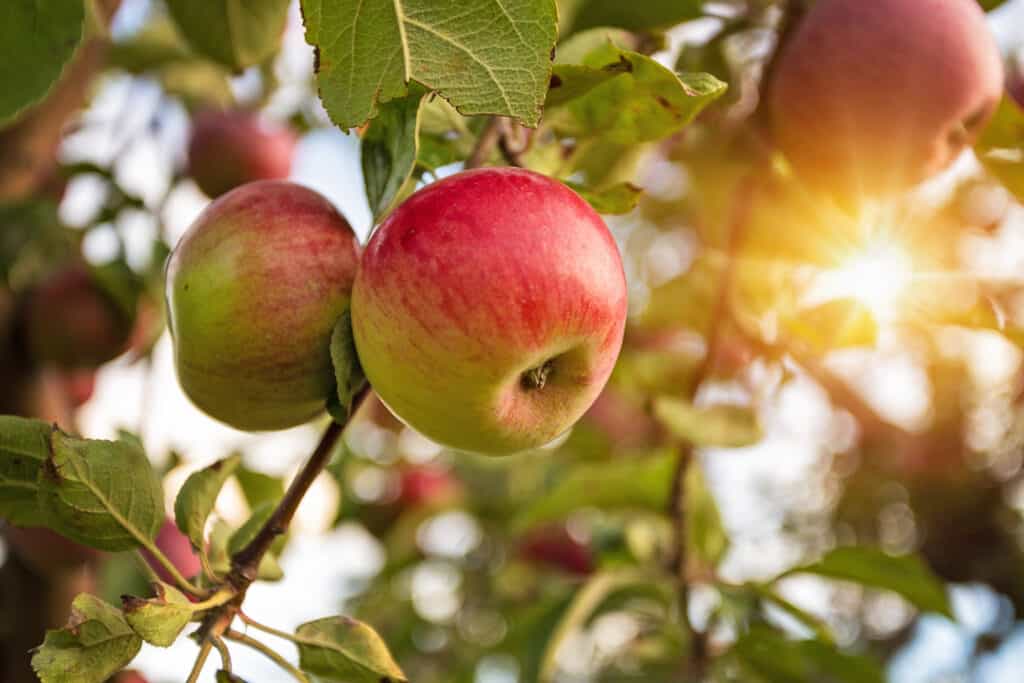Apple trees full of pink and white blossoms are some of the prettiest signs of spring. When apple trees bloom, they also delight the world with their sweet fragrance. However, apple blossoms come to life at different times in the spring, depending on factors like temperature fluctuations and varying tree types.
Unfortunately, sometimes apple trees don’t bloom at all.
In this post, we’ll explore peak apple season by Zone, why apple trees might not boom, and how to prolong the blooms on cut branches for display.

Spring apple blossoms become fruit in the summer and fall, depending on the tree variety.
©Nicholas J Klein/Shutterstock.com
Peak Apple Tree Season by Zone
The peak season when apple trees bloom varies depending on the climate in which they grow. A great way to find out when apple trees bloom where you live is to consult the USDA Hardiness Zones map.
Each Zone is determined by its average lowest temperature range. These ranges are valuable information for growers who need to know if trees and plants can survive the winter in their local climate.
The lower the Zone number, the colder the lowest average temperatures. For example, plants need to survive lower average winter temperature ranges in Zone 4 (-30 °F to -20 °F) than in Zone 7 (0 °F to 10 °F).
Apple Tree Bloom Timing
Before we look at when apple trees bloom per Hardiness Zone, we need to know if we’re growing “hardy” or “long-season” apple trees.
- Hardy Apple Trees
- Better suited for cold climates
- Typically hardy in Zones 3-5
- Long-Season Apple Trees
- Thrive in climates with longer warm seasons
- Generally hardy in Zones 5-8
Keep those apple tree types in mind as we explore when apple trees bloom in each Zone via the table below.
Most apple trees perform best in Zones 3–8. These climates are ideal because they allow for the right amount of chilled dormancy that apple trees need to produce blooms in the spring.
That said, there are also heat-tolerant apple tree varieties that can thrive in Zones 9–10. These low-chill apple trees don’t need as many weeks in cold dormancy as other cultivars.
| USDA Hardiness Zones | Apple Bloom Timing | Best Tree Types |
|---|---|---|
| Zones 3a-3b | Late spring, depending on the cultivar | Hardy apple trees like “Honeycrisp” varieties grow well in Zone 3. |
| Zones 4a-4b | Late spring, depending on the cultivar | Hardy apple trees like “Red Delicious” varieties grow best in Zone 4. |
| Zones 5a-5b | Mid to late spring, depending on the cultivar | Both hardy and long-season apple trees can grow well in Zone 5. For example, “Fuji” apples are hardy for Zones 4-8. |
| Zones 6a-6b | Mid to late spring, depending on the cultivar | Early to mid-spring, depending on the cultivar |
| Zones 7a-7b | Mid to late spring, depending on the cultivar | Long-season apple trees grow best in Zone 7. The “Granny Smith” apple is a great choice for Zones 6-8. |
| Zones 8a-8b | Early to mid spring, depending on the cultivar | Long-season apple trees grow best in Zone 8. For example, a “Gala” apple tree variety should do well in Zones 5-8. |
| Zones 9a-10b | Late winter to early spring, depending on the cultivar | There are fewer long-season apple trees that grow well in Zones 9–10, but they do exist! You could plant heat-tolerant varieties like “Ein Shemer” yellow apples or “Pettingill” greenish-red apples in these Zones. |

Apple trees need cross-pollination to produce flowers that become fruit.
©iStock.com/JBorruel
Why Didn’t My Apple Tree Bloom?
If some of your apple trees aren’t blooming, several factors could be causing the problem. Discover the possible reasons below to help you investigate any issues and correct them for future blooms.
Are your trees too young?
Young apple trees take years to mature before they start producing blossoms that turn into fruit. According to the University of Minnesota Extension, you can expect to wait the following number of years before apple trees begin to bloom:
- Standard apple trees may take as long as eight years to start producing blossoms that turn into fruit.
- Dwarf apple trees can take up to three years before producing flowers that become apples.
Did you over-prune your apple trees?
Over-pruning can alter an apple tree’s ability to bloom. Why? It’s all about something called tree vigor.
In a nutshell, an overly pruned tree can become an overly vigorous tree. An overly vigorous tree is one that focuses its energy mainly on wood growth, which stunts the growth of apple blossoms.
So, how do you prune an apple tree? We recommend following the pruning practices suggested by Mehrabyan Nursery in Ithaca, New York. Here are some of the basics:
- Give new apple trees at least three years of growth before you start pruning them so they can become established first.
- Only prune apple trees when they are dormant, ideally after the last frost in early spring.
- Prune apple trees into a cone or pyramid shape, with shorter branches at the top, around the one central leader limb that grows straight up from the ground.
- Remove dead and damaged apple tree branches or prune them to the nearest healthy buds on each limb. This pruning step should be done whenever dead or damaged branches appear, regardless of the season.
Are you growing enough apple trees together?
Apple trees depend on cross-pollination to produce fruit, which requires two important things:
- Pollination via bees
- Pollination with other apple trees
In addition to growing multiple apple trees for proper cross-pollination, you should also grow different tree cultivars together. However, each tree cultivar must have the same general bloom timing each year for successful cross-pollination between them.
If these conditions aren’t in place for healthy cross-pollination, your apple trees might not bloom.
Are you over-fertilizing your trees?
Over-fertilizing apple trees can cause low flower and fruit production because of excess nitrogen. An over-fertilized apple tree can also develop a bacterial disease called fire blight, which kills apple blossoms and sometimes entire trees.
A fertilized lawn or field can also hinder apple blossom production, even if you aren’t directly fertilizing your trees. So, test your soil first to determine its nutrient content before adding fertilizer where apple trees grow.
Are the apple trees getting enough sunlight?
If your apple trees are growing in the shade of taller trees and other structures, that could explain why they don’t bloom. Apple trees need full sun, which means at least 6–8 hours of sunlight per day.

To prolong apple blossoms on cut branches, remove limbs from the tree before their flowers fully open.
©iStock.com/Nataba
How to Prolong Cut Apple Blossom Branches
Since apple blossoms usually last under a week on a healthy tree, flowers on cut branches last even less time. However, the easy practices below can help your cut apple branches hold onto flowers for as long as possible.
- Cut apple branches off the tree just as their buds are beginning to bloom. When you remove these limbs from the tree, the blossoms will last longer on the cut branches if they aren’t fully open.
- Use sharp pruning shears for cutting branches from apple trees.
- Slit the bottom of each branch about 1-2 inches, and then smash each slit end with a hammer. This practice helps the cut stems absorb water to keep blooms alive longer.
- Remove any buds or blossoms below the water level in the vessel you use to display the branches.
- Keep apple branches in at least 6 inches of lukewarm water and replace the water daily.

Peak bloom and fruit season can vary between hardy and long-season types of apple trees.
©Romiana Lee/Shutterstock.com
Blooming apple trees are fragrant signs of spring.
In most climates, apple trees show off their pretty, aromatic blooms in the spring. Yet it’s important to know that timing can differ slightly between Zones and cultivars. In addition, always consider the specific growing needs of your apple trees to ensure they load up with blooms each spring for delicious summer and fall fruit. If your trees aren’t blooming, they may be too young or need some extra TLC to blossom again in years to come.
The photo featured at the top of this post is © AntiD/Shutterstock.com
Thank you for reading! Have some feedback for us? Contact the AZ Animals editorial team.







